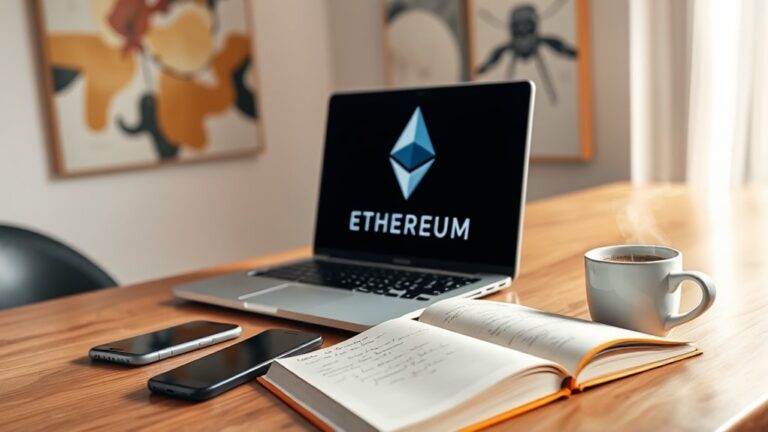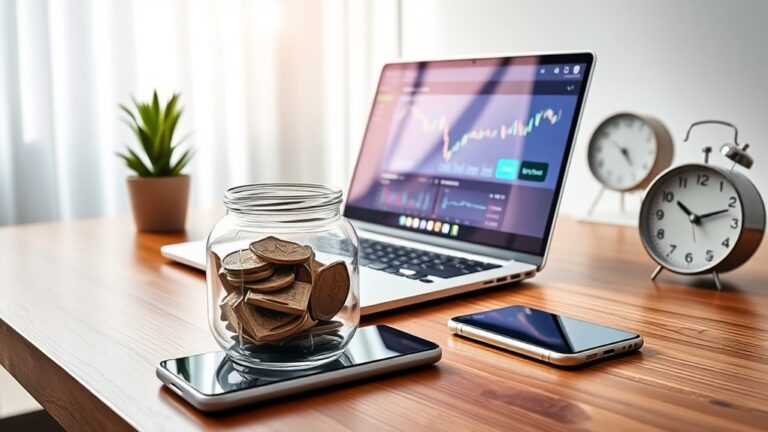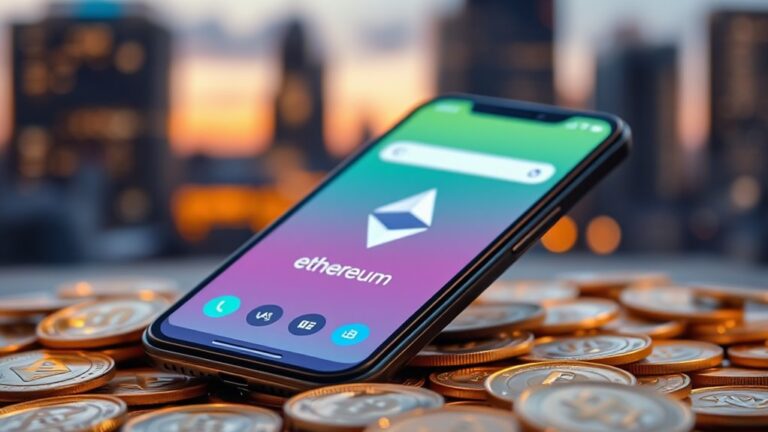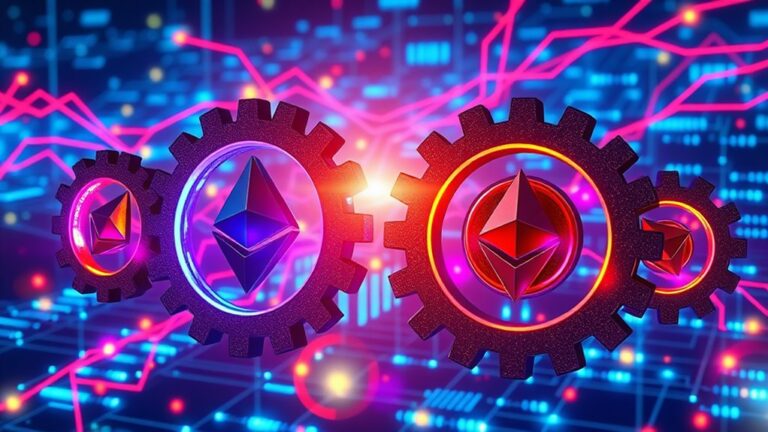
Ethereum’s Role in Web3 and Metaverse: Unlocking Smart Contracts and Decentralized Worlds
Ethereum serves as the backbone of Web3 and metaverse development through its programmable blockchain technology. By enabling smart contracts, Ethereum allows for the creation of decentralized applications, NFTs, and virtual asset ownership without intermediaries. The platform supports democratic governance through tokens and continues evolving with scaling solutions like Layer 2 technologies and sharding. Its integration with DeFi creates borderless financial infrastructure across virtual worlds, transforming how users interact with digital economies and environments.
Key Takeaways
- Ethereum’s programmable smart contracts enable decentralized applications that form the foundation of user-governed Web3 networks.
- Smart contracts automate transactions without intermediaries, serving as the operational backbone for decentralized applications in virtual worlds.
- NFTs built on Ethereum verify ownership of digital assets, powering virtual real estate markets and creator economies in metaverse platforms.
- Governance tokens allow community members to democratically influence platform development through transparent, blockchain-recorded voting processes.
- Layer 2 scaling solutions and Ethereum’s transition to proof-of-stake address network congestion issues for seamless metaverse experiences.
The Foundation of Web3: How Ethereum Changed the Digital Landscape

A revolution in digital infrastructure began when Ethereum emerged as the cornerstone of Web3 development. Unlike previous blockchain systems focused solely on cryptocurrency, Ethereum introduced programmable smart contracts that enabled decentralized applications to flourish. This innovation transformed the internet’s architecture, shifting from centralized control to user-governed networks.
Ethereum’s blockchain technology guarantees transparency and censorship resistance while supporting an ecosystem of thousands of applications. Through its native cryptocurrency Ether (ETH), the network incentivizes participation and facilitates transactions.
As the platform evolved, the introduction of token standards like ERC-20 and ERC-721 created frameworks for fungible tokens and NFTs, respectively. Recent upgrades, including the shift to proof-of-stake consensus, have addressed energy consumption concerns while maintaining Ethereum’s position as Web3’s foundational layer. Furthermore, the transition to proof-of-stake (PoS) enhances efficiency and sustainability, further solidifying Ethereum’s pivotal role in the decentralized web.
Smart Contracts: The Building Blocks of Decentralized Applications

Smart contracts represent the fundamental architecture upon which the entire Web3 ecosystem operates. These self-executing agreements use code to automate transactions when predetermined conditions are met, eliminating intermediaries and reducing costs. Operating on blockchain networks like Ethereum, smart contracts provide transparency and security through decentralization. Furthermore, they play a crucial role in the DeFi protocols that are transforming traditional financial systems.
| Application Area | Key Benefit | Real-World Impact |
|---|---|---|
| Finance | Automated Payments | Reduced Transaction Costs |
| Supply Chain | Enhanced Transparency | Fewer Disputes |
| Governance | Decentralized Decision-Making | Increased Participation |
Smart contracts serve as the operational backbone of decentralized applications (dApps), handling backend processes while enabling innovative use cases like DAOs. Their integration with technologies such as IoT and AI continues to expand their potential applications, making them essential components in the evolving Web3 landscape.
NFTs and Digital Ownership in Virtual Worlds

Non-fungible tokens (NFTs) have revolutionized the concept of digital ownership within the expanding Web3 ecosystem. These blockchain-based tokens verify authenticity and ownership of unique digital assets, creating scarcity in the digital domain similar to physical collectibles.
Within virtual worlds and the metaverse, NFTs serve several critical functions:
- Enabling ownership of virtual real estate, avatars, and in-game items with verifiable authenticity
- Supporting creator economies by allowing artists to monetize digital works directly and receive ongoing royalties
- Providing exclusive access to virtual events and restricted areas within digital environments
- Facilitating peer-to-peer transactions through decentralized marketplaces, eliminating intermediaries
Despite their potential, challenges remain in scalability, interoperability between platforms, environmental impact, and regulatory clarity—issues that ongoing technological advancements aim to address. Furthermore, the rise of decentralized applications (dApps) has contributed significantly to the adoption and functionality of NFTs in various sectors.
Scaling Solutions: Overcoming Ethereum’s Challenges in the Metaverse

While Ethereum has positioned itself as a foundation for Web3 and metaverse applications, significant technical hurdles have emerged as adoption increases.
Network congestion and high gas fees have created barriers to entry, particularly problematic for metaverse experiences requiring frequent, low-cost transactions.
In response, Ethereum has implemented several scaling solutions. The shift from Proof-of-Work to Proof-of-Stake through The Merge has improved energy efficiency, while Layer 2 technologies like Optimistic Rollups and ZK Rollups process transactions off-chain for greater efficiency. Additionally, these Layer 2 solutions help to alleviate the strain on the Ethereum network, enabling smoother user experiences in the metaverse.
Projects like SKALE Network offer zero gas fees to enhance user experience.
Future improvements include sharding, which will divide network data to increase transaction throughput, and proto-danksharding for improved data availability—critical developments as metaverse platforms demand increasingly seamless interactions.
Economic Revolution: DeFi Integration in Decentralized Environments

Ethereum’s DeFi ecosystem creates a borderless financial infrastructure that connects digital economies across Web3 and metaverse environments.
Within these interconnected spaces, users can engage in yield farming strategies that span multiple virtual worlds, generating returns from their digital assets regardless of geographic or platform boundaries.
The integration of governance tokens empowers community members to influence protocol development, creating democratized economic systems where stakeholders directly shape the financial frameworks that underpin their digital experiences. Additionally, decentralized finance fosters a more inclusive and efficient approach to financial services, enabling users to participate in peer-to-peer transactions without relying on traditional intermediaries.
DeFi’s Borderless Financial Infrastructure
Decentralized finance (DeFi) has established a revolutionary borderless financial infrastructure that operates independently of traditional banking systems.
Ethereum serves as the foundation for most DeFi applications, enabling smart contracts that automate financial transactions without intermediaries. This blockchain-based ecosystem promotes financial inclusivity by providing services to anyone with internet access.
DeFi’s key advantages include:
- Elimination of middlemen – Smart contracts facilitate direct peer-to-peer transactions
- Global accessibility – Financial services available 24/7 regardless of location
- User sovereignty – Complete control over assets through private keys
- Programmable finance – Customizable financial instruments with automated execution
Despite challenges like security vulnerabilities and regulatory uncertainty, DeFi continues to evolve, particularly with Ethereum‘s ongoing upgrades aimed at improving scalability and efficiency for worldwide adoption. Furthermore, the growth of decentralized autonomous organizations is enhancing the collaborative nature of DeFi, driving more community engagement and innovation.
Yield Farming Across Worlds
The economic landscape of virtual environments has undergone a profound transformation as yield farming emerges as a cornerstone of financial activity in decentralized worlds. Through smart contracts, users can stake or lend cryptocurrencies in virtual ecosystems to earn rewards, creating new economic opportunities across metaverse platforms.
This integration enables more flexible financial transactions and enhances the utility of virtual assets, as participants can leverage their holdings for passive income generation. Yield farming strategies—including lending, staking, and liquidity provision—operate seamlessly across blockchain networks thanks to cross-chain protocols that facilitate interoperability.
As the metaverse expands, it will increasingly rely on secure and decentralized transactions, further bolstering the role of yield farming in shaping economic models within these digital spaces.
While offering significant benefits, these systems face challenges such as smart contract vulnerabilities and impermanent loss.
Nevertheless, as Web3 technology advances, yield farming continues to shape increasingly sophisticated financial infrastructures within decentralized virtual environments.
Governance Through Tokens
Countless decentralized applications now leverage governance tokens as fundamental building blocks for democratic decision-making in Web3 ecosystems.
These tokens empower communities to collectively shape platform development, treasury management, and protocol parameters through transparent voting mechanisms.
Key elements of token-based governance include:
- Smart contract automation that executes approved proposals without intermediaries, ensuring transparent implementation.
- Economic incentives through staking rewards and liquidity provision that encourage active participation.
- Weighted voting systems that align influence with investment level, creating stakeholder accountability.
- DAO frameworks that enable community-driven management of decentralized platforms while maintaining security.
This governance model represents a significant shift from traditional corporate structures, creating systems where users directly influence the platforms they use rather than remaining passive consumers of centralized services. Furthermore, this innovative approach to governance is reminiscent of Initial Coin Offerings that allow for community funding and participation in project development.
The Road Ahead: Ethereum’s Evolution and the Future of Digital Interaction

As Ethereum continues to mature and evolve, its developmental roadmap represents a carefully orchestrated path toward addressing existing limitations while expanding capabilities for the future digital economy.
| Feature | Expected Impact |
|---|---|
| Danksharding | Reduces transaction costs through Layer 2 solutions |
| Verkle Trees | Minimizes storage needs for nodes, improving scalability |
| Single-Slot Finality | Decreases validation time with same-slot block finalization |
| Pectra Upgrade | Enhances user experience with features like account abstraction |
The shift to Proof-of-Stake through The Merge has already improved energy efficiency, while upcoming developments like shard chains aim to increase throughput dramatically. With EIP-7702 potentially enabling zero gas fees under certain conditions, Ethereum is positioning itself to overcome adoption barriers while maintaining its leadership in smart contract functionality. This evolution is further supported by Proof of Stake, which promotes security and incentivizes honest behavior among validators.
Frequently Asked Questions
How Do Ethereum Gas Fees Affect Metaverse Participation?
Ethereum gas fees can deter metaverse participation by increasing transaction costs, especially during network congestion. High fees reduce user engagement and can force developers toward alternative, more cost-effective blockchain platforms.
Can Traditional Businesses Easily Transition to Web3 and Ethereum?
Traditional businesses face significant challenges moving to Web3 and Ethereum, including technical learning curves, regulatory uncertainties, and business model restructuring. Success requires substantial investment in expertise, infrastructure, and strategic adaptation.
What Security Risks Exist for Smart Contracts in Metaverse Environments?
Smart contracts in metaverse environments face security risks including immutability challenges, vulnerability to exploits, identity authentication issues, and privacy concerns. These risks can lead to financial losses and compromise user trust.
How Do Different Global Regulations Impact Ethereum’s Metaverse Applications?
Like a ship steering through different maritime laws, Ethereum’s metaverse applications face fragmented global regulations. Jurisdictional inconsistencies create compliance challenges, with GDPR, financial regulations, and token classifications varying considerably across countries.
Will Quantum Computing Threaten Ethereum’s Blockchain Security?
Quantum computing poses a future threat to Ethereum’s security through algorithms like Shor’s, which could break cryptographic protections. However, Ethereum is implementing quantum-resistant solutions including lattice-based and hash-based cryptography to mitigate these risks.
Conclusion
Ethereum continues to reshape our digital reality, serving as the critical infrastructure for Web3 and metaverse applications. With over 4,000 active developers working on its ecosystem monthly, Ethereum remains the backbone of decentralized innovation. As scaling solutions improve and institutional adoption grows, Ethereum’s smart contract functionality will likely transform from experimental technology to essential infrastructure, potentially bringing decentralized ownership and interaction to billions worldwide.












